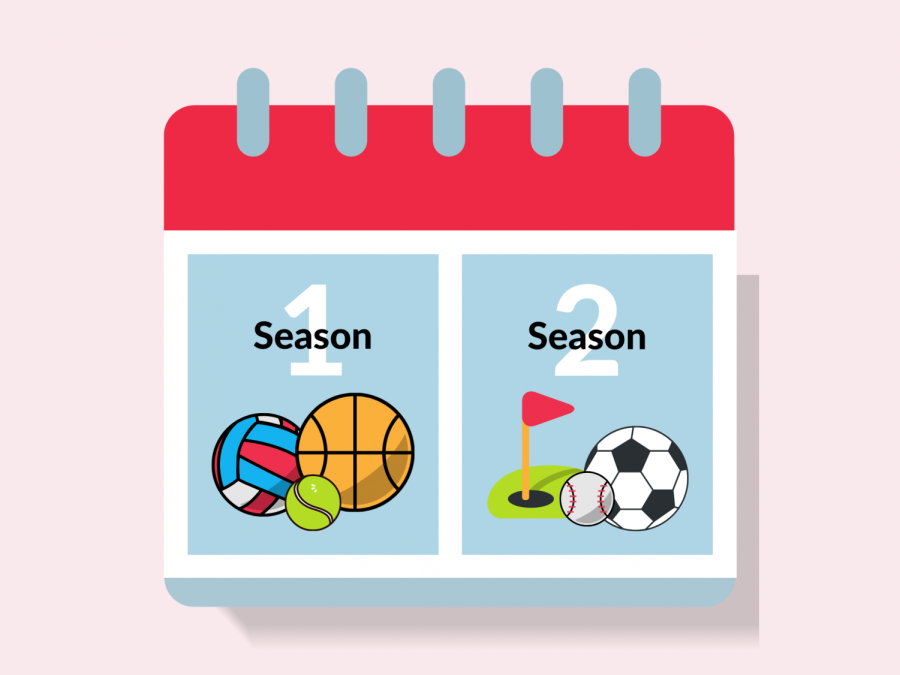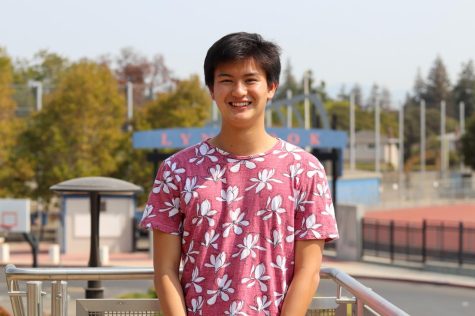Sports schedule changes bring challenges and hope
Graphic illustration by Bennie Chang
A calendar of the new seasons and the sports in each of them.
November 4, 2020
September brought new hope for Lynbrook athletes as many returned to campus to prepare for the upcoming seasons. Although practices have been altered to follow COVID-19 guidelines, Lynbrook athletics is officially back. Students are on campus training and pushing themselves and their teammates to new heights once again.
As the abnormal school year rolled around in August, sports schedules had to change. The California Interscholarship Federation (CIF) announced the 2020-2021 school year sports schedule on July 21, which reorganized the fall, winter and spring seasons into two seasons. The first season includes volleyball, water polo, cross country, cheerleading, football and field hockey. The second season will include badminton, soccer, swimming and diving, tennis, wrestling, basketball, golf, baseball, softball and track and field. One of the biggest differences is that Season 1 will begin at the end of the first semester on Dec. 14 instead of the usual start of the school year. As a result, practices and games for all sports will be condensed into one semester.
“Everything is going through the holidays,” Athletic Director Jennifer Griffin said. “There’s no such thing as a vacation this school year.”
Conditioning has already begun for some sports. For many of the teams that are currently practicing, students are no longer allowed to practice in indoor facilities.
“This season, we’ve only been able to practice outside, but I know everyone wants to get back in the gym and an indoor court,” said varsity basketball player Albert Huang. “We just started being able to share the ball as long as we’re all sanitized, and we also use the track when we’re trying to condition.”
The boys’ basketball season has been pushed back to March, as opposed to its usual start in November. Although the change has been awkward for Huang and many of his teammates, the extra three to four months give them more time to train and will help them to pave the way for a deep run in the Central Coast Section playoffs. The plan is to have a 24-game season, but this is subject to change due to the pandemic.
“The schedule for the season should be really condensed, and I heard we might have more games than practices during the preseason,” Huang said. “Right now, the gym isn’t open because of construction, but, hopefully, construction can finish before the season starts so that we get home games.”
Although teams do have to socially distance, multiple teams are allowed to practice at the same time as long as they are on different courts or on separate ends of the field. For many sports, the boys’ and girls’ teams are returning to practice at the same time. Boys’ and girls’ basketball, for instance, are both currently practicing in person, boys on Mondays and Wednesdays and girls on Tuesdays and Thursdays. When actual seasons begin, more teams like tennis will face the same issue.
“It is definitely not what everyone wants, but this is the best we can do,” said varsity tennis player Rebecca Gao. “It is kind of sad since it won’t be like a normal season; we won’t get to practice as much every week because now we have both boys’ and girls’ seasons at the same time. I just think that maybe we won’t be as well-trained as last year because we won’t get to practice as much.”
The current conditioning schedule for all sports has been traditional, with most teams practicing between 4 p.m. to 6 p.m. However, when Daylight Saving Time ended on Nov. 1, scheduling practices became more challenging, because the school only has one field with outdoor lighting and teams are not allowed to practice indoors.
Sports that do not require facility use have been more flexible. Cross country, for example, has been affected because it typically starts in the fall, but the team recently had its first official practice on Oct. 23. Despite the fact that cohorts, or training groups, have been limited to 12 people, practices have been relatively similar to those in the past because students do not have to utilize school facilities to practice. The team usually meets in front of the field house at the beginning of practice for announcements before breaking off into small groups to run.
However, for the actual competition season, many large sports with high participation like cross country, swimming and badminton are planning to cut some athletes because teams can no longer have as many participants. Nevertheless, many Vikings feel fortunate that they can still participate in sports despite the pandemic.
“Honestly I’m just grateful that we have a season at all, even though the games will be condensed and we have a shortened season,” Huang said.
Griffin is also glad that students are able to participate in sports this school year.
“Athletics is part of a comprehensive high school, so you have to have everything,” Griffin said. “Physical activity is what our kids need, especially after they’ve been sitting in front of a computer for six hours during class and doing homework, so I think that it is really important that we have a sports season.”
While the pandemic has taken away traditional school, friends and the norms of everyday life, the sport seasons have remained a much-needed outlet for many students. In spite of the changes, athletics keep the year moving, mark the seasons, give students something to look forward to and provide an escape from academics.




























































